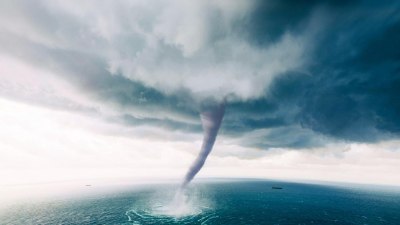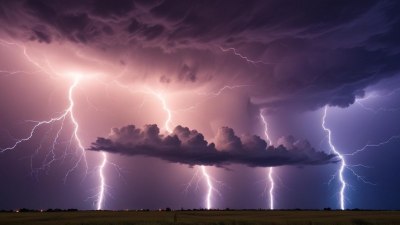How Tornadoes Form Over Water and Become Waterspouts
Discover the fascinating process of tornadoes forming over water and transforming into waterspouts.

Tornadoes are fascinating natural phenomena that can occur in various environments, including over water. When tornadoes occur over bodies of water, they are referred to as waterspouts. Understanding how these tornadoes develop and the conditions required for their formation is crucial for both meteorologists and the general public. In this article, we will explore the meteorological conditions that lead to the formation of waterspouts, the dynamics involved in their development, and the differences between tornadoes and waterspouts.
The Basic Mechanics of Tornado Formation
Tornadoes form from supercell thunderstorms, which are characterized by a rotating updraft called a mesocyclone. This rotation happens primarily due to wind shear, where winds at different altitudes blow at different speeds and in different directions. In a conducive environment, the mesocyclone can tighten and stretch, leading to the potential of tornado formation. However, the dynamics can be different when these phenomena occur over water.
The Role of Water Temperature
One of the defining factors influencing the formation of waterspouts is the temperature of the water compared to the air above it. Warm water can provide the necessary heat and moisture to the air above, causing the air to rise. This rising warm, moist air can contribute to the formation of a thunderstorm, which is vital for waterspouts. In many cases, waterspouts arise from unstable conditions where warm, humid air is present over cooler water.
Types of Waterspouts
There are primarily two types of waterspouts: fair weather waterspouts and tornadic waterspouts. Fair weather waterspouts generally form in less severe weather conditions and are usually not associated with thunderstorms. They develop in areas where warm, moist air rises, creating a visible rotation. When these waterspouts do occur, they are typically weak and dissipate quickly.
Tornadic Waterspouts
In contrast, tornadic waterspouts are more serious and dangerous. These waterspouts originate from severe thunderstorms with strong rotating winds, meaning they can share characteristics with traditional tornadoes. Tornadic waterspouts are often associated with supercell thunderstorms and can produce hazardous conditions, capable of causing damage to boats, structures, and even land if they travel ashore.
Formation Process of Waterspouts
The formation process of waterspouts involves several key steps. Initially, a thunderstorm needs to develop, which requires the presence of sufficient moisture, instability in the atmosphere, and a source of lift. Once a thunderstorm develops in a favorable environment, an updraft begins to form. If this updraft is strong enough and there is adequate wind shear, a rotation can develop, leading to a mesocyclone. Under certain conditions, this rotation can stretch downward and interact with the water's surface, resulting in the formation of a waterspout.
Waterspout Characteristics
Waterspouts exhibit some distinct characteristics when compared to their land-based counterparts. For one, waterspouts tend to be shorter-lived, often lasting only a few minutes before dissipating. They also tend to be less intense, though some can be quite powerful. The visible funnel of a waterspout is typically comprised of water vapor, which forms as moist air is drawn upward and begins to cool. The visual appearance can change dramatically, with the funnel often appearing to be less defined and more diffuse compared to a land tornado.
Impacts of Waterspouts
Despite their often less intense nature, waterspouts can still be dangerous. The winds associated with strong waterspouts can reach high speeds, similar to those found in tornadoes, leading to the potential for damage. Boats and ships caught in a waterspout’s path can experience capsizing, damage or even sinking. It is crucial for people on or near the water, such as fisherman or recreational boaters, to be aware of changing weather conditions that could lead to waterspouts.
Recognizing Potential Waterspouts
To stay safe, it is essential to learn how to recognize signs that could indicate the formation of a waterspout. Some common indicators include the development of dark, ominous clouds and rapid changes in wind direction. Additionally, the presence of rain shafts and shifting wind patterns can signify that a waterspout may form. Meteorological tools, such as radar, can also help forecasters track storm systems that may be capable of producing waterspouts.
Safety Precautions
If you are in an area where waterspouts are a possibility, it is wise to take precautions. If you spot one forming, it is advised to immediately head for shore and anchor in a safe location. Avoid being on open water, as high winds and rough waves can create dangerous conditions. If you are caught outside during a waterspout, it’s crucial to remain calm, avoid trying to outpace it on water, and follow any safety instructions provided by local authorities.
In conclusion, understanding how waterspouts form can significantly enhance safety for those who operate in or around open water areas during stormy weather. By recognizing the conditions that lead to their formation, we can better prepare for the potential dangers associated with these fascinating and powerful weather phenomena. As our understanding of meteorology evolves, so too does our ability to predict and respond to such natural occurrences, ensuring the safety of people who may find themselves in danger from these waterspouts.











